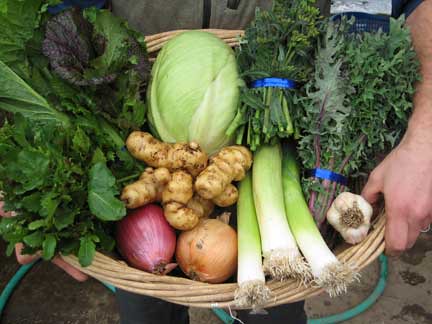(CSA Newsletter: Early Season Week 7)
Meet this week’s vegetables:

Out here at the farm, we are still waiting to start planting into our new field for the year. We’ve had some beautiful weather this last week, but it’s been tempered by off-and-on soaking rainstorms and wind. The ground still hasn’t dried significantly enough for us to work it for planting.
Oh well. We’ve been discussing our rainy reality a lot, because it’s always on our mind. Until we actually plant, we will both be constantly thinking about when we’ll get to plant (and then we read other farmers’ blogs and find out that other people have planted, and then we worry a bit more). We had already planted this time last year, which doesn’t help assuage our worries. Until now, each year of farming everything has occurred earlier than the year before. Now we’re looking at getting our plants in the ground several weeks later. It’s an obvious fact that we can’t ignore, especially now that we have an almost year-round CSA to serve.
But harvests such as this week’s help buoy our spirits: the growing abundance of greens in our old fields is a treat after a winter of roots and cabbages. In fact, we still have about two acres of ground planted to harvestable over-wintered vegetables. A fact that helps calm our nerves and not shake our fists at the sky.
We’ve also chosen to be more philosophical about the goal to ‘get on the ground early.’ We farm in Oregon. Spring here is rainy. And unpredictable. We can more or less rely on a few dry enough spells to get things in the ground, but we also rely upon the rest of spring being constantly wet. And, no matter how much we care or worry, we will never ever change the weather. Unless we accept that truth, we will always be unhappy and/or frustrated with farming.
In the end, that’s not such a profound idea, but it’s one of those realities that we need to be constantly reminded about. It’s so easy to mentally lump weather in with the rest of the factors we can control: especially in the spring when we’re making long, seemingly endless ‘to do’ lists. Our list might reasonably contain the item, ‘spread feathermeal,’ but we can’t reasonably list ‘stop raining.’
Fortunately, we can add items to our list that help us adapt to the current weather trends. So, we’re sowing some seeds into flats for later transplant that we had hoped to direct sow: peas and spinach, for example. In doing so, the plants will be farther along in their maturity by the time we can get on the ground and plant. Overall, transplanting these items means more physical labor for us, but it also gives us a way to respond to the factors we can’t change in our environment. And, I think that’s about all we ever do as farmers: take action in response to the uncontrollable.
Who knows? — maybe it will dry out next week and we would have been able to direct sow peas just fine, but we like to take action. Taking action means more to use than just ‘hoping’ for something. Positive plans, goals, and action — that’s what keeps us sane and makes us feel like we’re halfway effective farmers.
Well … and big beautiful bunches of kale like those we’re giving out this week also help make us feel like we’re ‘good’ farmers. Whenever we feel down, vegetables bring us back up. Rain or shine, enjoy this week’s vegetables!
Your farmers,
Katie & Casey Kulla
Oakhill Organics


